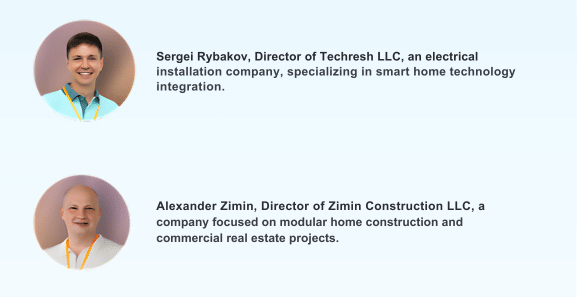By: Zhang Shiyue
Smart home systems are becoming increasingly popular worldwide, offering numerous benefits, from automating household processes to enhancing security and energy efficiency. However, despite these advantages, many Americans are hesitant to adopt these technologies in their homes. To understand why this is happening and what can be done to change the situation, we spoke with two experts: Sergei Rybakov, Director of Techresh LLC, and Alexander Zimin, Director of Zimin Construction LLC.
High Cost of Installation and Maintenance
One of the main reasons why Americans are reluctant to install smart systems in their homes is the high cost of these technologies. Installing smart devices requires significant financial investments, including purchasing the devices themselves and paying for the services of qualified specialists.
“In the U.S., the pay for such specialists is among the highest in the world,” comments Sergei Rybakov. “The average hourly rate for an electrician in the U.S. is around $50-100, depending on the region and level of expertise. This significantly increases the overall costs of installing smart systems, especially considering the work can take several hours or even days.”
Alexander Zimin adds, “Many people are simply unwilling to figure out and assemble a smart home on their own. Of course, you can buy components on Amazon or eBay and build a system yourself based on Alexa, Google Home, or Apple HomePod. This would be much cheaper but requires certain knowledge, skills, time, and desire. Some Americans lack the motivation to delve into this.”
Solutions
There are several potential solutions to reduce these costs. Government support through subsidies and grants for installing smart systems can significantly reduce the financial burden on consumers. Continued development and production of more affordable devices and creating a competitive environment among manufacturers will also help lower prices. “Conducting educational programs and courses for specialists can also help reduce service costs by increasing the supply of qualified professionals,” adds Sergei.
Issues with Rental Housing
Many Americans live in rented apartments and houses. Renters are generally reluctant to invest in improving properties they don’t own, and landlords may not approve significant changes to the infrastructure.
“This makes installing smart home systems in rental properties challenging,” explains Sergei Rybakov. “The solution to this problem lies in developing mobile smart devices that do not require significant changes to the infrastructure, as well as implementing programs and tax incentives for landlords who install smart systems in their properties.”
Alexander adds, “There are remote devices that don’t require installation into the electrical system, such as access control systems, security systems, and lighting control systems. This can be a convenient solution for rental housing.”
Housing as an Investment
For many Americans, housing is an investment. They spend money on improvements that increase the property’s value. Smart systems don’t always increase a home’s market value, especially if buyers aren’t familiar with these technologies.
“Information campaigns aimed at raising buyers’ awareness of the benefits of smart homes can change this situation,” says Sergei. “Additionally, introducing standards and certifications for smart homes can make them more attractive in the real estate market.”
Need for Permits
Any significant modification to a home in the U.S. requires obtaining special permits. This includes installing smartsystems, especially replacing electrical wiring or altering the building structure. The permitting process can be lengthy and costly, which increases expenses and deters many people.
“Simplifying and speeding up the permitting process for installing smart systems can help reduce time and costs,” believes Sergei. “Lowering requirements for installing certain types of smart devices that don’t require significant changes to the infrastructure can also simplify their adoption.”
Habits and Prejudices
Many people are simply accustomed to traditional ways of managing their homes and don’t see the need for new technologies. Additionally, there are concerns about the security of smart systems – fears of hacking and data breaches.
“Educational programs and training can show users how to use smart technologies and how beneficial they can be,” explains Sergei. “Moreover, developing and implementing more reliable security systems for smart devices can minimize risks and alleviate concerns.”
Alexander agrees: “Very few people are willing to delve into and assemble a smart home themselves. For most, hiring a team of specialists is easier, but this significantly increases the cost. We are currently implementing a project where just the setup and adjustment of a smart home costs $300,000. That’s more than the cost of a small home in some states.”
Expert Opinions and Insights
Alexander Zimin shares his perspective on why smart homes are not more widespread:
“Most people aren’t willing to figure out and assemble a smart home themselves. If you want a smart home, you have two options: buy components on Amazon or eBay and build it yourself, or hire a team to do it for you. While DIY solutions can be cost-effective, they require knowledge, skills, and time that most people don’t have.”
“For example, in one of our current projects, the total cost of equipment is less than $10,000. High-quality switches with smart home functions might only be $10 more expensive than regular ones. However, the setup, adjustment, and maintenance can add up to $50,000, and we are currently working on a project where the setup alone costs $300,000. In many states, you could buy a house for that amount.”
“Smart devices also need to be certified in the U.S., which adds complexity and cost. And while smart devices can save energy and enhance convenience, they require a significant investment to install and maintain.”
Sergei Rybakov also notes the challenges:
“Smart home systems are more justified in premium segments where the cost can be offset by significant savings on heating and cooling. For smaller homes or rental properties, the cost savings on electricity might not justify the investment.”
Sergei continues, “There is also a lack of motivation among many Americans to understand and manage these systems. For most, hiring a team of specialists is easier, which again drives up costs. Simplifying user interfaces and providing better education on the benefits of smart homes could help bridge this gap.”
Final Thoughts
Smart home systems have enormous potential, but they remain out of reach for many Americans. High costs, issues with rental housing, using real estate as an investment, the need for permits, and user habits – all these factors hinder the widespread adoption of smart technologies.
However, according to recent data, the smart home market continues to grow. In 2023, the market valuation of global smart homes was $100.42 billion, and by 2025, the number of homes using smart devices is expected to reach 478.2 million. Despite slower growth rates in some segments, such as smart speakers and networked video entertainment devices, the overall number of devices like Alexa, Google Assistant, Siri, and Google Home is projected to exceed 5.5 million by 2030.
“To ensure more Americans appreciate the benefits of smart homes and decide to implement these systems in their residences, we need to continue working on reducing costs, simplifying procedures, and raising user awareness,” concludes Sergei Rybakov.

Photo Courtesy: Sergei Rybakov / Alexander Zimin
Published by: Khy Talara









